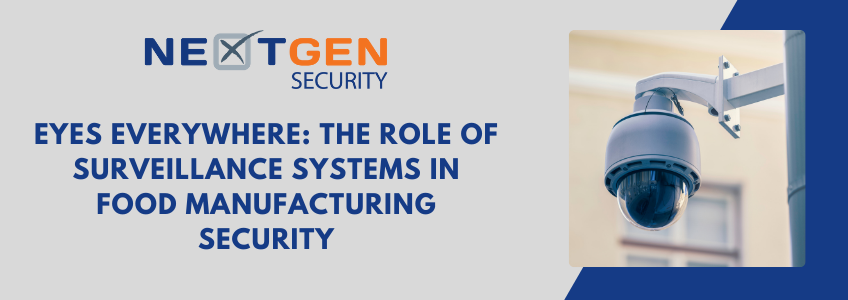In our previous blog, we explored how access control solutions help food manufacturing facilities protect their operations and guard against activities that could jeopardize the quality and safety of their food products. Potential breaches in security in these facilities could result in food contamination or tampering and, in turn, pose a serious risk to public safety.
In addition to access control, video surveillance systems are also integral to a solid security strategy in food manufacturing environments.
The food production business is bustling. There’s a multitude of processes going on at the same time, making the potential for threats and risks especially high. The round-the-clock eyes of properly placed surveillance cameras can keep watch over an entire facility and provide real-time monitoring to proactively defend against damaging incidents.
Video technology has matured markedly since the initial emergence of CCTV. Advanced CCTV technologies and video analytics have delivered a whole new level of capabilities and sophistication to video surveillance. High-definition cameras, thermal imaging, and video analytics have significantly elevated the value and operational efficiencies that video surveillance systems can provide.
Today’s high-def cameras capture much clearer and more detailed footage for end users, as they allow for more detailed monitoring of production processes, storage areas, and access points. The ability for cameras to do this is priceless when it comes to identifying potential issues and threats. Surveillance systems not only enhance security for food processing plants, they also keep an eye on operations to safeguard the quality of food products. Cameras that monitor production lines can identify issues such as equipment malfunctions, product defects, or deviations from quality standards, and they facilitate swift corrective actions that proactively protect public health and the reputation of the specific food manufacturing facility.
It’s a proven fact that the mere presence of visible cameras can deter potential intruders or in-house individuals that seek to do harm. And, in the event an incident does occur, recorded video footage qualifies as indisputable evidence for investigations that greatly helps law enforcement and internal security teams to correctly identify perpetrators and gain a full understanding of what transpired.
Thermal imaging capabilities have also been instrumental in mitigating risks. Case in point – in areas where temperature control is critical, which is especially important when it comes to food manufacturing and safety, thermal imaging cameras can detect and send alerts when anomalies that may indicate equipment malfunctions, fire hazards, or other environmental concerns, occur. Food quality is integral to the integrity of public health, so this sorely needed capability is instrumental in warding off any potential threats of contamination or other risks.
Advances in video analytics have also elevated the level of security that food manufacturing facilities can harness. The new reality is that video analytics powered by artificial intelligence (AI) contribute directly to enhanced and more efficient surveillance. These systems can automatically detect and alert security personnel to unusual activities, unauthorized access, or deviations from normal operations – all key to the smooth and safe operations of food manufacturing facilities.
There are many published real-world Case Studies highlighting the advantages of video surveillance systems in food manufacturing facilities. One, for instance, details how video detected a potentially dangerous instance of food contamination.
Case Study: Early Detection of Contamination
A large-scale food processing plant implemented a comprehensive surveillance system with advanced video analytics. The system detected an anomaly in the production line, leading to the immediate identification and removal of a contaminated batch of products. This early detection not only prevented a potential public health issue but also saved the company from significant financial losses and reputational damage.
Another highlights how deterrence, employing video surveillance, resolved an incident before it could escalate:
Case Study: Deterrence and Incident Resolution
A food storage warehouse installed visible surveillance cameras in key areas. The mere presence of these cameras acted as a deterrent, reducing the incidence of theft and unauthorized access. In the rare instances of security breaches, the recorded footage facilitated swift resolution and the apprehension of the culprits.
We at NextGen always adhere to best practices for implementing trusted and robust surveillance systems for all our clients, including those working in food manufacturing that have specific needs we can surely meet.
Some of the best practices we assist them with include identifying critical areas for surveillance, including production lines, storage facilities, and access points, and strategically positioning cameras to assure that video footage coverage is comprehensive and all-encompassing.
We also recognize the importance of integrating surveillance systems with any and all existing access control and alarm systems to deliver a unified and more sophisticated security approach and better ability to respond even more quickly to incidents. And we regularly maintain our surveillance equipment to eliminate downtime and ensure that cameras are always functioning optimally.
We at NextGen are adept at protecting the safety and integrity of food manufacturing facilities, not only to protect them, but also to protect the public against any possible risks of food tampering or contamination. Call on us today to elevate the level of security at your facility.

